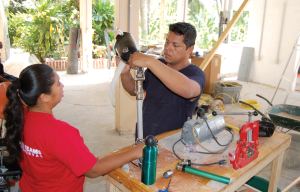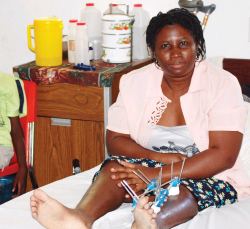
On January 12, 2012, Haiti reached the two-year mark since the devastating earthquake occurred just west of its capital, Port-au-Prince. According to the World Health Organization (WHO), more than 200,000 people were killed. The International Committee of the Red Cross (ICRC) estimates that more than 300,000 people were injured. Though some clearing of debris has occurred, the capital and surrounding area remains strewn with rubble and partially collapsed buildings. More than 890,000 displaced Port-au-Prince residents have migrated to other parts of Haiti, and the once heavily populated city of 1.5 million now houses more than 500,000 persons in tent cities, according to WHO and International Organization for Migration (IOM) reports.
Prior to the earthquake, Haiti’s disabled population was underserved, shunned, and mostly invisible due to social stigma, financial and accessibility barriers, and a void of vocational training. The addition of more than a quarter-million persons with disabilities is forcing Haiti to recognize and integrate this population into the fabric of its society. It also has created opportunities for those who help to rehabilitate and empower individuals with disabilities. Nonetheless, if the various non-governmental organizations (NGOs) providing medical care for Haitians are to be successful in transforming this country and empowering its population over the long term, one thing is imperative: sustainability.

While sustainability is the maxim for development movements, the concept is vital if Haiti is ever to evolve from the cycle of dependence that defines it. Those providing care to Haitians must teach and involve Haitians in the process, so in the future Haitians themselves can provide care to their own population. In the months following the earthquake, a tremendous influx of international providers emerged with an emphasis on prosthetic care. Initial estimates of up to 8,000 amputees after the earthquake proved to be excessive for two reasons. First, no accurate data-collection infrastructure existed, and second, in the weeks and months following the disaster, significant numbers of individuals with one or more amputations passed away due to secondary complications from acute infections. Most officials agree that the actual numbers of amputees resulting from the earthquake were closer to 2,000-3000, but Al Ingersoll, CP, of Healing Hands for Haiti (HHH) believes the figure to be in the range of 1,000-2,000. Ingersoll’s estimate is in keeping with WHO and Handicap International (HI) estimates. (Author’s note: Various organizations, such as WHO, estimate that there were between 8,000-14,000 individuals who had one or more amputations prior to the quake.)
In the months after the earthquake, 14 different O&P facilities were established within a two-hour radius of Port-au-Prince and began to serve the acute needs of the injured who had survived the critical months following the quake. Now, two years after the disaster, some of these facilities have departed and more are winding down as funding and the acute need diminishes. What is left is a broader landscape of O&P services and the promise of developing the talent of the indigenous Haitian population into a sustainable industry that serves the needs of the country’s disabled community.



In the decade preceding the earthquake, only 40 percent of the Haitian population had access to any type of healthcare services. WHO and Merlin, a U.K.-based international health charity, report that only a few organizations provided full-time prosthetic and/or orthotic care to the country’s entire population of eight- to ten-million people. In 1998, HHH began to provide full-time O&P services from its campus in Port-au-Prince. HHH employed six Haitian technicians and up to 40 other Haitians in various supportive roles. HHH enjoyed a stable flow of dedicated North American and European practitioners to provide clinical guidance and a temporary manpower boost for up to six months at a time. One hundred miles to the south in Les Cayes, the Advantage Program, established in 2001, provided physical and occupational therapy and full-time orthotic services with a staff of three and prosthetic care from U.S. practitioners who periodically donated their time in two-week intervals. The hallmark of both programs is the commitment of the directors and their commitment to sustainability.
The country directors of these programs, Ingersoll and June Hanks, PT, PhD, DPT, respectively, both left secure employment in the United States after the quake to live full time in Haiti and lead their organizations’ efforts. Ingersoll left a full-time position as a prosthetist at Winkley Prosthetics and Orthotics, Minneapolis, Minnesota, and Hanks left a tenured professorship with the University of Tennessee at Chattanooga’s physical therapy program. After the earthquake, the HHH campus was almost completely destroyed, and Ingersoll immediately began to salvage equipment to quickly reestablish the facility. Hanks had to increase the capacity of a facility that previously served a much smaller population. Both faced the immediate challenge of securing or selling their homes stateside and obtaining a residence in Haiti. Once in country, both positioned their programs to meet the immediate needs of the quake victims and seized the advantage of being in country to advance their visions of their respective programs’ sustainable futures. The confluence of O&P providers in Haiti since the earthquake and the synergy created by this larger group provides hope for the future of the O&P industry in Haiti and for its more than 800,000 residents with disabilities.



Although the HHH facility was all but destroyed in the quake, partnerships with HI and the ICRC allowed for rapid salvaging of materials and equipment and resumption of services. To the south, the Advantage Program partnered with Medical Teams International and hired two International Society for Prosthetics and Orthotics (ISPO) Category II O&P practitioners and two technician trainees to expand its services, hosting teams of volunteers to assist in the work. While both programs count the number of prostheses provided post-quake in the hundreds, Ingersoll and Hanks recognize that the need for quality orthotic care far exceeds the prosthetic need. Ingersoll estimates a 3:1 ratio of orthotic to prosthetic need. Hanks indicates that a majority of patients served by the Advantage Program have congenital or acquired neurological or musculoskeletal conditions requiring orthotic intervention for improved function.
With an eye toward the future development of medical professionals for Haiti, HI and HHH focus on sustainability through training. A USAID grant has been secured so that HI and HHH can partner jointly with Don Bosco University, El Salvador, to provide training for up to 30 Category II O&P practitioners. Rehabilitation technicians will be trained as well. The ICRC is nearing completion of a new, three-story, 14,000-square-foot building at the former HHH site and hopes that the O&P facility can relocate by March or April of 2012. Ingersoll hopes to have USAID funding to consolidate and connect up to five centers throughout Haiti to build capacity and eventually to incorporate trained physical therapists, occupational therapists, and rehabilitation personnel into the Haitian Ministry of Health.
The Advantage Program provides “physical empowerment” through its rehabilitation clinic, which offers not only O&P services but also physical rehabilitation therapy. The Advantage Program moved its main clinic to a location near its newly constructed laboratory and established a mobile clinic model, including an outreach clinic in Port-à-Piment. One of the Haitian technical trainees was accepted to the Don Bosco program, and the program hopes that future graduates and Haitian therapists will anchor additional outreach clinics. Hanks sees the rehabilitation component as only a part of the sustainable attributes of the program. A micro-lending program augments the educational stipends that the Advantage Program provides to persons with disabilities under the “economic and educational empowerment” component. “Children and young people with no cognitive defect, but with even a minor physical challenge are often denied admission to a regular school due to social, financial, and architectural barriers,” Hanks says. “Vocational training is limited in general and especially lacking for persons with disabilities. To meet that deficit, the program provides school sponsorships for persons with disabilities to finish regular school and/or vocational school as a means toward financial independence. Integrated education is the key to affecting societal attitudes.” When their education and training are complete, program participants may establish small businesses or work in the public or private sector, enabling them to become active participants in their communities and empowering them to gain control over the resources available to them. The program’s advocacy group “Vwa Nou,” meaning “Our Voices,” reaches out to persons with disabilities through peer counseling, support-group meetings, and through community event planning. With the help of organizations such as the Jordan Thomas Foundation, Passing Hope, and others, the Advantage Program extends the “socialization component” by organizing male and female amputee soccer teams to participate in regional and national competitions.
Hanks and Ingersoll see a brighter future for O&P care in Haiti because of the contributions of the NGOs that entered Haiti after the quake and plan to remain a vital part of the country. The University of Miami, Florida, Project Medishare established the only critical-care and trauma hospital in Haiti when it renovated the partially destroyed Hospital Bernard Mevs in Port-au-Prince. Project Medishare’s prosthetic program has made more than 300 limbs and includes a comprehensive rehabilitation component and a training program for Haitians. They also have created an amputee soccer program to reconnect the Haitians with their national sport.

Johanniter International Assistance of Germany brought 14 aid workers to Haiti and established a medical facility in the city of Leogane, the epicenter of the quake. Johanniter International’s commitment to sustainability is evidenced by the fact that it immediately doubled its staff by hiring 15 Haitians. It then added two trained psychosocial counselors to work with the amputee population and help these individuals reintegrate into society. Johanniter International is now focusing on the education of O&P technicians and rehabilitation technicians.
There are many other NGOs serving in Haiti including ProsthetiKa and the Hanger Ivan R. Sabel Foundation Clinic located at Hôpital Albert Schweitzer in Deschapelles, which is about two hours north of Port-au-Prince, to name a few. (Editor’s note: For more information about the Hanger Clinic, see the Q&A with Ivan Sabel in this month’s issue, “An Update on the Hanger Clinic in Haiti” ).
Ingersoll and Hanks are encouraged by the continuing level of commitment to sustained progress in Haiti after the acute need of prosthetic devices was met. “Almost everyone in Haiti was touched by the earthquake because they know someone who was killed or disabled,” Ingersoll says. This fact alone will go a long way in helping to change the social norms that isolated persons with disabilities in the past. When asked what their concerns and hopes are for the future, Ingersoll and Hanks admit they are concerned that the funding and commitment will dry up as the acute need diminishes and a service gap will develop between now and the time the first Haitians graduate from training programs. Ingersoll emphasizes the need for long-term mentors and ISPO Category I clinicians to continue to provide clinical care until the Haitians awaiting the start of the education program have graduated. Hanks voiced the need for a national university-based training program for physical and occupational therapists, and for longer-term commitments (six months to one year) from Category I professionals to allow for appropriate mentoring of existing O&P trainees.
Pablo Picasso (1881-1973) once said, “Inspiration does exist, but it must find you working.” If we combine the countless inspirational stories of courage and survival of Haiti’s disabled population with the tireless work of hundreds of dedicated O&P professionals, we just might see a masterpiece of sustainable care in Haiti’s future.
Jim Rogers, CPO, FAAOP, is practice manager of Pinnacle Orthotics & Prosthetics in Chattanooga, Tennessee. He served as a visiting prosthetist-orthotist in Chatemal, Mexico, from 1994-1999 and has been serving in Haiti since 2000.




